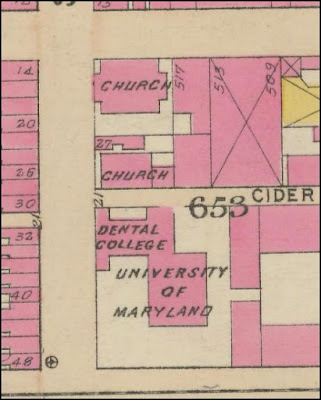506 Barre Street West of Little Green Street
Formed in 1858 as a mission of the Episcopal Diocese. A brick building was underway in late 1858 and opened for use in 1859. Its location in the Pigtown put it literally in the shadow of the bustling B & O Railroad yards.It parishioners coming from the workers at the B&O would have consisted primarily of skilled semi and unskilled workers on the B & O Railroad. As walking to work was the most common method for all bu the most wealthy, the rail road workers would have lived near the job site, and churches were also near the job site.
Over the ensuing decades, the little parish had its share of ups and downs, always following the boom & bust cycle of the rail industry. Though always considered a church, and not a "chapel" It never reached full independence. By the late 1890s the diocese turned over the responsibility to Old St. Paul's who were also supporting another chapel a few blocks away.In 1902 St. John's was merged with St. Paul's Chapel, which had erected a new larger building at the corned of Columbia Pike and Callender st.
In 1902 the St. John's building was put up for sale and was purchased by a Lithuanian independent Catholic congregation. At that time considered the first church in the United states to carry out the service in the Lithuanian language.
The building was used in this capacity until the late 1940s when the city took over a large swatch of land for the building of Russell Street, then the city end of the Baltimore Washington Parkway.
For a while the property languished as Russell St was not going to consume the actual property, and the city was planning to build an Elementary School for the African American children in that area.
Much opposition was made as the property was very unsuitable for a school. It is probable that the church was demolished during the Russel Street construction.
 |
| from The MD Churchman C 1902 |
 | |
| form MD Churchman c 1902 |
 | ||
| 1896 Baltimore City Atlas |













































